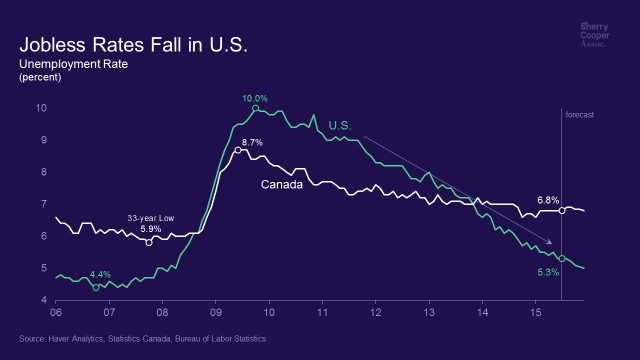Articles
Posted on August 7, 2015
Canadian Jobs All Part-Time, U.S. Sees Broad-based Job Gains
The divergence between the Canadian and U.S. economies continues as the July employment data reveal Canadian weakness and U.S. strength. The Canadian economy added 6,600 jobs last month as services-related sectors continued to offset job losses in manufacturing and natural resources. The gains reflected more self-employed and part-time work, with the number of full-time jobs falling 17,300. The unemployment rate was unchanged at 6.8 percent.
Professional services is a pocket of strength for Canada, but weakness in manufacturing employment has been puzzling to policymakers given the fall in the Canadian dollar, which should make manufactured products more competitive. Factories shed 4,600 workers in July in a sector that has had no net new employment growth in the past 12 months. Manufacturing export strength was supposed to offset the job losses in the oil patch, but to date, there has been little evidence of this hope.
The trade figures, released earlier this week, did show some manufacturing export improvement, but not in autos and auto parts, by far the most important sector for Ontario. The annual retooling shutdown in the auto sector reduced auto production to a four-year low. The service sector has also been weaker than expected, with the exception of professional services which showed job gain in July.
The debate over whether Canada is in a full-fledged recession will continue. Certainly, the economy contracted in the first half of this year, but consumer spending and housing are still robust, which will likely continue until interest rates start rising. Growth this year will be no more than 1.2 percent, so rate hikes by the Bank of Canada are off the table and additional rate cuts cannot be ruled out.
In direct contrast, U.S. employers added 215,000 jobs in July on the heels of an upward revision in June employment and the unemployment rate held steady at a seven-year low of 5.3 percent–very close to the 5- to 5.2 percent level that the Federal Reserve considers to be full-employment. The Fed is clearly on a path toward raising interest rates as soon as next month. Most economists predict that the Fed will hike the overnight rate by 25 basis points on September 17, their first rate hike since 2006.
Trend growth in the U.S. is solid and continues to chip away at the slack in the labour force. The economy is likely to grow at a 2.4 percent pace this year, depressed by the temporary slowdown in the first quarter.
Reflecting this tale of two central banks, the U.S. dollar strengthened as the Canadian dollar fell immediately following the release of these data.
